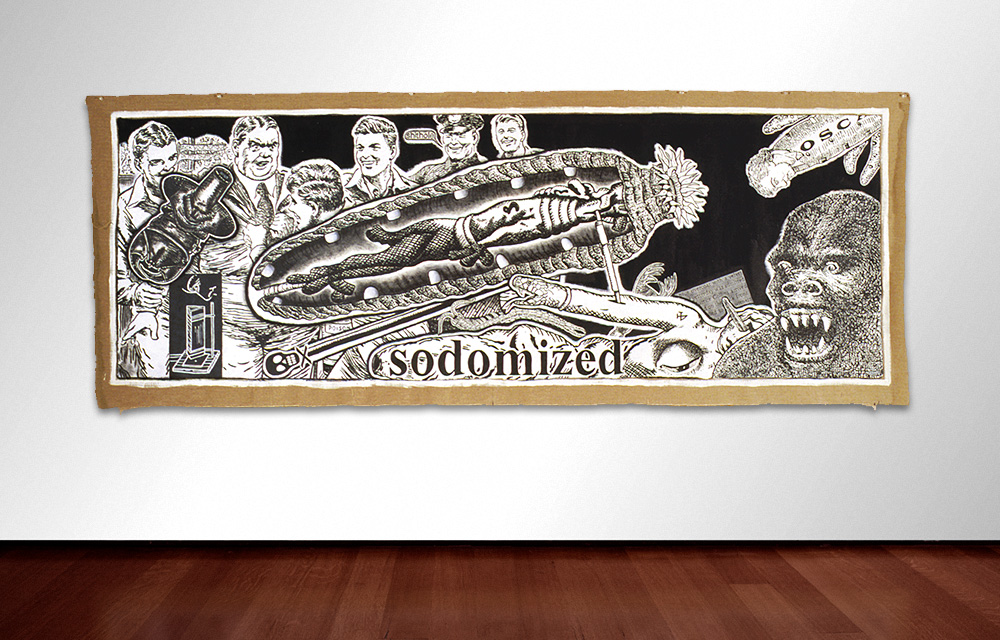


Ross Moore, a Melbourne painter, a writer on art and, more recently, an academic, came to prominence for work theorising issues of the gay body and the HIV-AIDS crisis in the mid-1990s. He attracted particular attention with his banner-pieces in the major exhibition Don't leave me this way: art in e age of AIDS (National Gallery of Australia, 1994), and his accompanying survey show Active agents: AIDS art in Australia (Canberra School of Art, 1994–95). Moore refigures current issues by reflecting on popular graphics from the era of his boyhood, spent at Broken Hill in remote New South Wales. A series of works dealing with kitsch representations of Aboriginal identity (the exhibition Dear primitive: black bodies as décor, 1994) make Moore one of the rare non-Indigenous artists to tackle this difficult terrain, made fertile for him by parallels between the experiences of homophobia and racism.
Sodomized (1995) is one of a set of four mural paintings in acrylic on unstretched canvas, whose physical format alludes to older popular media-like union banners and temporary mural decorations. Effectively painted collages of mass-media fragments, as Ted Gott observes, 'their comic-book dimensions are real enough. For many gay men the spectral theatre of AIDS, from bearing witness to the illness and loss of friends, to coping daily with inflammatory media coverage of the epidemic and the silent accusations ... has assumed the unreal proportions of some grotesque B-grade strip story.'1
Moore's use of black and grey on white give his work an unequivocal theatrical impact. Compared to his earlier hand-painted images, Moore relies here upon imagery retrieved from 1950s comic books like the Boys own manual, more recent hand-drawn gay porn strips, and zoological or medical treatises. Images and bodies float in a crisp black space; cartoon bubbles feature the artist's scatalogical texts; while each of the murals sports an emphatic title: Sodomized, Discovered, Hystericalized, (Per)formed. Moore has explained, 'The paintings are full of monstrous forms, to represent the way in which the homosexual body is seen as a contaminating body, demonised, which threatens, like a B-grade predator'.2
Thus the huge gorilla head of King Kong appears as a public bogey on the right; above him, the homosexual Oscar Wilde is portrayed as a repulsive beetle. In the centre, Moore converts the textbook cross-section of an elongated sea, with its gut and sphincter, into a container for vivisection. Inside it, the body of a dog bound at the feet is tormented with surgical tubes. Below it a (gay) man’s body is metamorphosed with insect and reptilian appendages. Such images can be seen a allegories for the medicalisation of the gay body. The clinical condition of HIV-AIDS is transmuted into horror by homophobic moral outrage. 'I'm looking at the extraordinarily theatrical way that the heterosexual imagination fantasises the homosexual body in order to define itself,' Moore added in interview.3
The top left of the painting broaches the idea of gay subjection to societal discipline: here comic-book heterosexual authority figures, including a policeman, appear to brutalise a gay youth. While Moore's is unashamedly a work of activist art, it can be admired for its visual polish, emotive impact, and the imaginative depth it brings to the task of allegorising 'the measurement and dissection of the gay community by the mainstream media'.4
- Roger Benjamin
For further reading on the life and work of Ross Moore, visit Design & Art Australia Online.